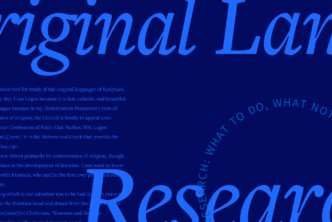If you’ve ever heard evangelicals discuss English Bible translations, you might think they’re talking about Israelite spies, of whom we sing, “Ten were bad and two were good.” I’m not here to tell you which are which, but instead to explain the theory behind a particular class of translations, those following a functional (or “dynamic”) equivalence approach. I’ll then briefly critique functional translations and offer some opinions about what, and whom, such translations are good for.
Functional translations
Functional translations are a diverse lot, but they tend to share a cluster of traits.
First, they aim for a high degree of clarity. The reader shouldn’t struggle to understand the text; as the New Living Translation says in its preface, the text’s “meaning [should be] readily apparent to the contemporary reader,” allowing “the message to come through with immediacy.”
Second, functional translations are idiomatic, using “words and forms that are widely accepted by people who use English” (so says the Good News Translation). Thus, word choice, word combinations, syntax, and flow of text should sound natural rather than foreign, stilted, or awkward.
Third, a functional translation judges faithfulness in terms of accurately conveying the meaning of the text, rather than literally translating individual words. The New Century Version, for example, claims to “accurately communicate the messages found in the original languages”—the messages, as opposed to the words.1
Formal translations
Functional translations stand in contrast to formal translations, in which the translator reflects, to the extent possible, the “form” of the original text—not instead of communicating the text’s meaning, but as the best way of communicating the text’s meaning. Thus, the formal translation is primarily oriented toward preserving the voice of the original author; the functional translation is primarily oriented toward communicating the message to the reader. Voice and meaning matter in both approaches, but the relative balance is different.
Eugene Nida
The functional equivalence approach to translation was articulated and developed between the 1950s and 1990s largely as a corrective to non-English translations that were, as linguist and translation consultant Eugene Nida put it, “excessively literal and in no sense represented accurately” the languages they were translated into.2
Nida argued instead for translations that convey in the receptor language the dynamics of the text: its poetry, its emotion, its pleas, its personality, and, of course, its meaning. Nida’s “dynamic” (later renamed “functional”) approach revolutionized how Bible translation was done by missionary translators, and since the 1960s many major English translations have adopted Nida’s approach, too.
Major functional English translations are summarized below. What holds these diverse translations together is their explicit commitment to a functional or dynamic approach. What distinguishes among them is the balancing act between maintaining the original author’s voice (a formal concern) and clearly communicating the meaning (a functional concern).
Two examples
Two examples from Matthew can help us see what functional translations share in common with each other, and also how they differ.
1. Blessed are the poor in spirit
Jesus begins the Sermon on the Mount with the famous utterance, “Blessed are the poor in spirit.” Among functional translations, the NIV, NET, and REB follow the KJV: they all retain the image, the metaphor of using poverty to illustrate a spiritual state; they all put a focused adjective at the beginning of the sentence (which is not common in English); they all keep the traditional “blessed”; none adds any explanatory language.
Compare the GNT, NLT, and CEV. Of these, two retain the image of poverty, while the CEV replaces the metaphor with the straightforward “depend.” Only the GNT keeps the distinctive adjective-first sentence structure that characterizes the Beatitudes—but it is also unique in dropping the traditional word “bless”. Meanwhile, the CEV and NLT spell out where the blessing comes from: it’s God who does the blessing. Most importantly, all three explain Jesus’ image of spiritual poverty.
This first Beatitude is typical of what functional translations do with figurative language that—the translators judge—is hard to understand. The NIV and NET are restrained: like their more formal counterparts, they leave it to readers to listen attentively, reflect, and maybe even ask a more experienced reader or teacher for help understanding. At the other end of the functional spectrum, the translators are committed to making “the message … come through with immediacy.”3
The formal features of the original—the “blessed” at the beginning of the clause, the brevity, the unexplained metaphor—all work against immediate comprehension, and may even lead to serious misunderstanding, so functional translations change the form in various ways. Either the sentence structure is reworked, or information is added, or the metaphor is explained. Readers may not hear Jesus’ distinctive voice, but they’re also not at risk of wildly missing the point.
2. Great is your faith
Consider now Matthew 15:28, which comes at the end of the story about the Canaanite woman rebuffed by Jesus. Jesus, amazed by the woman’s faith, exclaims (in formal translations such as the KJV), “Great is your faith.” Here we have the same sort of clause that is used in the Beatitudes—a predicate adjective followed by a noun phrase. But in this case, every functional translation gives us what the translators must think is a more natural structure in English.
It’s in places like Matthew 15:28 that we see functional translations united in using “idiomatic English.” It’s not normal in English to say something like “great is your faith.” (But it’s not bad English either—unless Walt Whitman’s line “Great is the English speech” is in fact not-so-great English.) So functional translations all avoid what they judge to be unusual English to represent the structure of Greek and Hebrew, even when the English structure is possible. It’s worth noting that only the REB achieves a really good English exclamation here.
What functional translations are good for
Across the board, the functional translations tend to help people read faster and comprehend the meaning (or some core aspect of it) more quickly. The more restrained functional translations offer this benefit in smaller doses: in order to preserve the voice of the original, many challenging expressions are left in. But when it’s simply a matter of making the language more idiomatic, even the restrained functional translations don’t hesitate to transform the structure of the original into one familiar to their intended readers.
For the less restrained functional translations, this benefit comes at a higher cost. In their book From One Language to Another: Functional Equivalence in Bible Translation, Nida and de Waard observed that biblical language “employs many symbols, is filled with metaphors and metonymies, and makes extensive use of poetic forms,” giving scriptural language an “open-ended” quality.4
They go on to say that “explanatory and exegetical” language “is not the language to be employed in the translation of Scriptures.”5 Many major functional translations have ignored this advice, regularly offering explanations in place of figures, closing off what, in the original, is intended to be open-ended. But in my view, such translations nevertheless have a use.
Thoroughgoing functional translations like the NLT and REB are good, first, for teachers and preachers to read alongside more formal translations. A solid functional translation will offer common-language expressions that are useful for explaining to a class or congregation the meaning of difficult biblical language. It can even serve as a concise commentary on the meaning of the text.
The ordinary Christian committed to regular Bible study and reading will also benefit from such comparative reading. More than that, because of their commitment to readability and easy comprehension, such translations are ideal for taking in long passages or even whole books quickly so as to get a sense of the main ideas. Finally, Bibles of this type may help weak readers of English, as well as readers who are not connected to a Christian community.
Restrained functional translations like the NIV are more suitable for what I would call primary use: regular, repeated private reading; public reading in worship; preaching and teaching. This is especially true if there is a community of teaching and interpretation to help the reader; indeed, the more restrained or formal a translation is, the more need there is for such a community. Such translations respect the original author’s voice, they retain most symbolic language, and their stylistic revisions are less severe. One can read such a translation without constantly wondering what the author really wrote.
Nevertheless, the commitment to even modest functionalism involves tradeoffs, and many will find that a solidly formal translation that pays attention to English style will richly repay the patient, committed reader. Above all, for any reader of any translation, one must know what the translators have aimed to do, and judge and use the translation on those terms.

***
This article was originally published in the March/April 2021 issue of Bible Study Magazine. Slight adjustments, such as title and subheadings, may be the addition of an editor.
Related articles
- The Best Bible Translations: All You Need to Know & How to Choose
- How to Choose a Good Bible Translation: 5 Guidelines
- What Counts as “Literal” Bible Translation?
Related resources
Translating Truth: The Case for Essentially Literal Bible Translation
Regular price: $12.99
The Challenge of Bible Translation: Communicating God’s Word to the World
Regular price: $15.99
- The Everyday Bible: New Century Version (Nashville: Thomas Nelson, 2005), Introduction.
- Fascinated by Languages (Philadelphia: J. Benjamins, 2003), 14–15.
- Tyndale House Publishers, Holy Bible: New Living Translation (Carol Stream, IL: Tyndale House Publishers, 2015), Introduction.
- Eugene Nida and Jan de Waard, From One Language to Another: Functional Equivalence in Bible Translation (Nashville: Thomas Nelson, 1986), 21.
- 22.




